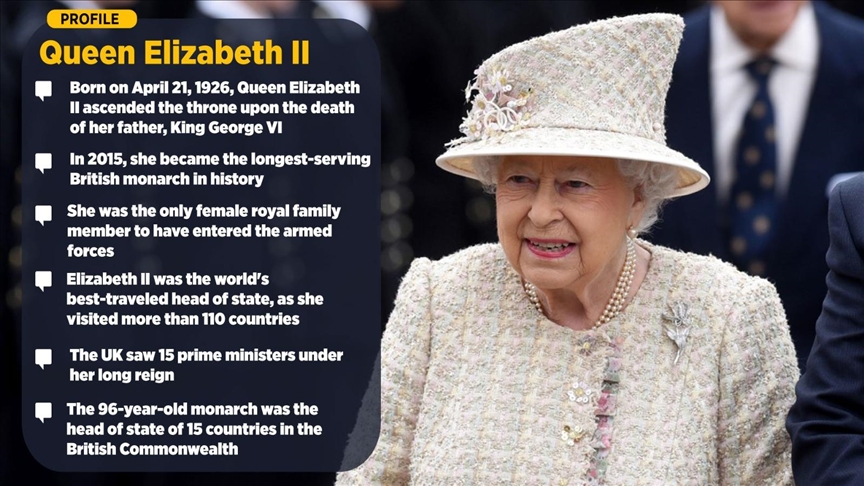PROFILE - Queen Elizabeth II: Britain's longest-serving monarch
Having ruled Britain for nearly 1 century, Queen Elizabeth II leaves mark on country's history with vast record of firsts, controversies

LONDON
Born on April 21, 1926, Queen Elizabeth II ascended the throne upon the death of her father, King George VI, on Feb. 6, 1952.
In 2015, she became the longest-serving British monarch in history, exceeding even the reign of her great-great-grandmother Queen Victoria, who sat on the throne for 63 years and seven months.
Elizabeth was also the first-ever British monarch to see the platinum jubilee, honoring her 70 years on the throne.
She was the only female royal family member to have entered the armed forces.
Elizabeth II was the world's best-traveled head of state, as she visited more than 110 countries but never used a passport as she did not have one. She was also the only person in the UK who was allowed behind the wheel of a car without a driver's license.
Her official visit to then-West Germany in 1965 was the first German visit by a British royal since before the outbreak of World War I.
Elizabeth visited Türkiye twice: Once in 1971, making stops in the capital Ankara plus Izmir, Istanbul, and the historical Ephesus and Canakkale, and a briefer visit in 2008, which also included the northwestern city of Bursa.
Nuptials and controversy
On Oct. 21, 1966, an avalanche of mud and water from a coal mine killed 116 children and 28 adults in the village of Aberfan in South Wales. A week later, the queen visited the site but faced criticism as some thought she should have gone sooner.
On July 29, 1981, an estimated 750 million people in 74 countries came to watch her son Prince Charles marry Lady Diana Spencer at St. Paul's Cathedral in London.
In another first for a British monarch, Elizabeth visited the Chinese mainland in 1986.
The queen and royal family also faced public criticism after Princess Diana's 1997 death in a Paris car crash. Elizabeth refused to allow the flag to fly at half-mast over Buckingham Palace or address the grieving nation over the much-loved princess.
But, she soon revised her stance on the flag, greeted crowds of mourners, and delivered a rare televised address.
Some international developments of great importance during the queen's reign include the 1956 Suez crisis, 1962 Cuban missile crisis, 1967 Six-Day War (Arab-Israeli War), 1969 moon landing, 1979 Iranian Revolution, 1989 Fall of the Berlin wall, 1991 breakup of the Soviet Union, 1992 Maastricht Treaty (EU Treaty), 1994 Rwandan genocide, 1994 election of Nelson Mandela as South Africa's president, Sept. 11, 2001 terror attacks in the US, 2016 Brexit vote, and 2020 coronavirus pandemic.
When Elizabeth II took the throne in 1952, the leader of the USSR was Joseph Stalin, and the US president was Harry S Truman.
The UK saw 15 prime ministers under Elizabeth's long reign, from the stately but controversial Winston Churchill to the newest Conservative leader Liz Truss.
The 96-year-old monarch was the head of state of 15 countries in the British Commonwealth, including Australia, Canada, New Zealand, Antigua and Barbuda, the Bahamas, Belize, Grenada, Jamaica, Papua New Guinea, Saint Lucia, Solomon Islands, St. Kitts and Nevis, and St. Vincent and the Grenadines and the non-Commonwealth states of Gibraltar, the Falkland Islands, Bermuda, and the Cayman Islands.
Anadolu Agency website contains only a portion of the news stories offered to subscribers in the AA News Broadcasting System (HAS), and in summarized form. Please contact us for subscription options.








